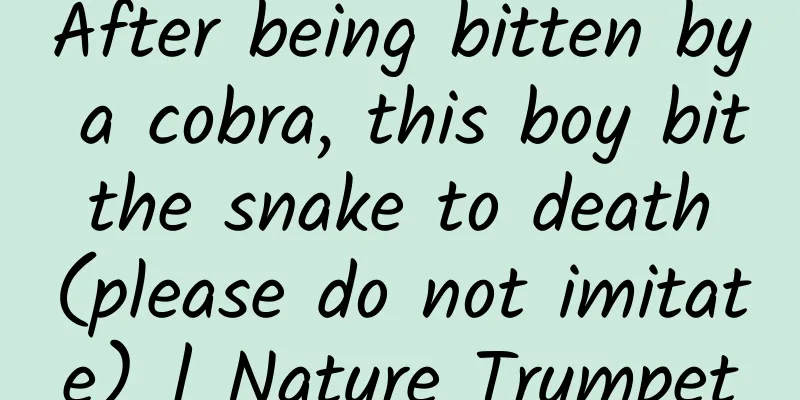After being bitten by a cobra, this boy bit the snake to death (please do not imitate) | Nature Trumpet

|
Welcome to the 22nd issue of the Nature Trumpet column. In the past half month, we have collected the following natural news and research worth noting: 1) A cobra bit a person, but was killed by the person 2) How do octopuses fight? They throw sand at each other. 3) “Shark Guard” appears, and the sharks are saved 4) It turns out that the bird that disappeared for 140 years is not extinct! 5) The smallest horse in the world is about the same size as a dog 6) Stay with resistant corals to keep them healthy cobra:??? Recently, a cobra was bitten to death by an 8-year-old boy - yes, you read that right, it was a cobra that died . This happened in India. A little boy named Deepak encountered a cobra while playing. The cobra wrapped around his hand and bit him. Deepak was horrified and tried desperately to get rid of the snake, but it didn't move at all. In this emergency situation, Deepak simply bit the snake twice - and the snake died! Deepak | Dailymail Deepak was taken to a nearby hospital by his family for snake venom treatment. The doctor found that there was no venom in the area where Deepak was bitten , but this does not prove that the snake that bit Deepak was non-venomous. Venomous snakes have a defense mechanism called "dry bite" - just bite without releasing venom, after all, the production cost of venom is high and must be used on the blade. Venomous snakes usually use "dry bite" to warn large animals: I don't intend to kill you, but you'd better stay away. Every year, there are about 5.4 million snake bites worldwide, half of which contain venom, resulting in 138,000 deaths. India is the country with the highest number of deaths from snake bites in the world, with about 46,000 people dying from venomous snakes every year. The "tit-for-tat" method is actually very dangerous, as you may ingest germs and parasites from wild animals. But Deepak was very lucky. Not only did he survive, he also bit the cobra to death, and even became famous for it, appearing on major international news. Octopus fight How do octopuses fight—by swinging their eight long legs and punching and kicking each other? Recently, scientists have found the answer: their fighting method is to throw sand at each other! Octopus tentacles are not used to hit each other directly, but to collect sand, shells and other debris from the seabed, and use them as raw materials for "shotguns" . Then, the octopus will use the siphon under the tentacles to drain the water flow to provide power for launching the "shotguns". A male octopus attempts to mate with a female octopus and receives a large octopus instead | Godfrey-Smith et al., 2022 The scientists studied 102 instances of octopuses throwing sand recorded by underwater cameras. They found that about 53 percent of the cases occurred during interaction with another octopus, a fish, or the camera (yes, they also hit the camera with sand), and 32 percent occurred while the octopuses were cleaning their nests. Launching "shotgun": biubiubiu! | Reference [2] What should the targeted octopus do? When they realize that they are about to receive a "shotgun", they will raise their tentacles in the direction of the thrower - researchers speculate that this may mean that they have entered a state of readiness, or suspended their original actions and quickly escaped. Throwing objects at each other is unusual in the animal kingdom. Aside from octopuses, only a few social mammals have been known to throw objects at each other (including, of course, humans who throw objects at each other when they get angry). Octopus Wars | References [2] Defend Sharks A new invention called " SharkGuard " can save countless hapless sharks. It's this amazing little thing! | Robert Enever About 20 million sharks are caught by fishermen every year. Worse still, they are not the target of fishermen - fishermen are mainly looking for tuna and other commercial fish, but the longline fishing method they use often makes sharks bycatch . Longline fishing method | Ecomare/Oscar Bos / Wikimedia Commons Shark Guard is designed to prevent accidental catch. When attached to a fishing line, it emits a small pulsed electric field . When a shark or ray passes by a baited hook, the electroreceptors on their bodies detect the electrical signal from Shark Guard and they move away from the hook. Is Shark Guard really effective? Researchers conducted a sea trial in France. Two fishing boats went out to sea 11 times, with more than 18,000 hooks installed. As a result, compared with ordinary hooks, the sharks and rays caught with the Shark Guard hooks decreased by 91% and 71% , respectively, while the catch rate of tuna remained almost unchanged. Fishing gear equipped with Shark Guard | Robert Enever However, the current "Shark Guard" is not perfect - it needs to replace the battery frequently, which is troublesome for fishermen. Scientists are working hard to overcome this problem and strive to make it a device that fishermen can install and forget about. The reappearance of the black-naped pheasant pigeon A bird that disappeared for 140 years has recently reappeared! That's it! | Jason Gregg / American Bird Conservancy This is the Black-naped Pheasant Pigeon (Otidiphaps nobilis), a large ground-dwelling bird that belongs to the same family as the Dodo. Its head and tail are black, and its back is rusty. The last time anyone saw a Black-naped Pheasant Pigeon was in 1882. Apart from the two specimens left at that time, there is no information about them. Many people believe that they became extinct after a brief appearance. But a group of ornithologists did not give up. They recently formed an expedition team and came to the only habitat of the Black-naped Pheasant Pigeon - Ferguson Island in Papua New Guinea. For a month, they searched everywhere and installed cameras in places where black-naped pheasants might appear, but found nothing. Just when everyone was dejected and ready to go home, a miracle happened - in front of the remote camera, a black-naped pheasant was flapping its big tail and walking leisurely. Black-naped Pheasant Pigeon appears in front of a remote camera|Jason Gregg, American Bird Conservancy For explorers, this surprise was like suddenly discovering a unicorn; for the locals, it also meant something special - although no one had ever seen a black-naped pheasant, this bird had long been a part of local legends and culture. However, no one can be sure whether this suddenly appeared black-naped pheasant pigeon will be the last member of this species . Next, the expedition team will return to the island to carefully investigate the existing population size of the black-naped pheasant pigeon. After confirming that the bird captured by the camera was a black-naped pheasant, everyone was overjoyed|Wild Birds of New Guinea The smallest horse in the world (preliminary version) The Guinness World Record for the smallest horse is about to be broken! Why is it about to be broken? Because this young horse is only 3 years old. According to the rules, to obtain the official title of the world's youngest horse, it must be at least 4 years old . Seeded players | INA FASSBENDER/AFP/East News It is called Pumuckel, a male Shetland pony , with a shoulder height of 50.8 cm. The average Shetland pony weighs about 120 kg, but it weighs only 35 kg. The current Guinness World Record holder for the smallest horse is an 8-year-old Appaloosa horse, with a shoulder height of 55.9 cm. It is a miniature horse like Pumuckel. Pumuckel can win the title only if he does not grow wildly in the next year. Pumuckel and other miniature horses. Even among miniature horses, he looks very small. | INA FASSBENDER/AFP/East News Although Pumuckel is small, he lives a happy life. He often plays with miniature horses that are taller than him, and is sent to nursing homes and kindergartens to visit the elderly and children. Everyone who sees him likes him very much and can't help but hug him. Because of his short stature, he has a privilege - other horses have to sit in a trailer, but he can sit on the passenger seat of the car. Just like that, I got in the passenger seat! | Michael Kleinrensing / Westfalenpost Miniature horses are the result of 400 years of artificial breeding. Miniature horses were originally bred as working horses because they could work in the small spaces of coal mines. But now, miniature horses have become pets and are no longer needed for work. Although miniature horses are cute, their offspring have a certain chance of suffering from dwarfism and may have health problems. Pumuckel has not yet undergone genetic testing, so people don't know whether he has the disease. Corals help corals! There is a good way to keep corals that are prone to disease healthy - stay next to corals with good resistance! In a new study, researchers tracked 650 cultivated corals over five months and found that corals with the same genotype living together were more likely to develop white band disease , a serious bacterial disease, than corals with mixed genotypes. Coral reef | Rebecca Jackson / Wikimedia Commons In further research, they discovered something amazing - some corals did not get sick just because they stayed next to corals with super resistance. Corals with high disease resistance act like a barrier , helping their companions keep the disease out and preventing bacteria from spreading to susceptible individuals. This phenomenon is not uncommon in the biological world. In farmland, single-crop planting is more likely to be infected with disease than diversified crop planting. Corals help corals! | Jerry Reid / Wikimedia Commons This new discovery can be applied to coral reef restoration projects. For example, if a coral reef is damaged, people can fill it with corals of mixed genotypes , allowing those corals with high disease resistance to "escort" their weak companions, so that the coral reef can recover faster. References [1] https://www.livescience.com/child-kills-venomous-cobra [2] https://doi.org/10.1371/journal.pone.0276482 [3] https://doi.org/10.1016/j.cub.2022.09.003 [4] https://phys.org/news/2022-11-lost-pigeon-century.html [5] https://www.livescience.com/unofficial-worlds-smallest-horse [6] https://www.nature.com/articles/s41598-022-23457-6#Sec3 Author: Cat Tun Editor: Mai Mai This article comes from the Species Calendar, welcome to forward If you need to reprint, please contact [email protected] |
<<: Are beverages healthy if they use sugar substitutes?
>>: "Hitting a tree can improve your health"? Wrong! Be careful of serious problems
Recommend
How does the Foshan Financial Mini Program work? How to promote financial WeChat mini-programs?
With the development of mobile Internet, finance ...
After studying the 5 subway screen-swiping incidents, I found an interesting thing
The subway is very busy this year and is often po...
Wuhan high-end tea tasting club takeaway tea sn most reliable contact information
Wuhan high-end tea tasting consultation 132-7243-...
What time is it today? What month and day is Jingzhe? Here are some beautiful sentences to welcome the spring during the Jingzhe solar term!
What time is Jingzhe today? What month and day is...
Introduction to the advantages of 360 search promotion display advertising system!
What is the display advertising system? Display a...
94.1% of people have experienced “forgetting words when writing”, and now we finally know the reason!
How long has it been since you last wrote with a ...
[Creative Cultivation Program] "From fish to humans" has more evidence, is the human middle ear transformed from fish gills?
Author: Liu Sen Recently, there is a very interes...
Heavy rain hit Mianning, Sichuan at night and killed a family of five. 2020 is truly an extraordinary year!
On the evening of June 26, heavy rain and torrent...
Do you know how hard scientists have worked to find aliens?
Not long ago, a fake "alien" body was b...
2021 Tik Tok Marketing Plan
In this marketing plan: 1. Douyin has built a ric...
Getting Started with SEO, How Do Newbies Learn SEO?
SEO website optimization, this technology has a h...
Apple releases seventh developer beta of iOS 12
In the early morning of August 14, Apple released...
World Migratory Bird Day丨As a migratory bird that is almost "forgotten", why is the migration route of the relict gull so different?
Produced by: Science Popularization China Author:...
Zhiji Auto and Volcano Engine have reached in-depth cooperation in the fields of model application and algorithm
On April 25, 2024, the 2024 Beijing International...
There is no artificial intelligence in the world? Are we fooled by deep learning?
The author, Jean-Christophe Baillie, founder and ...









